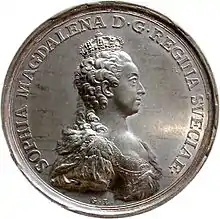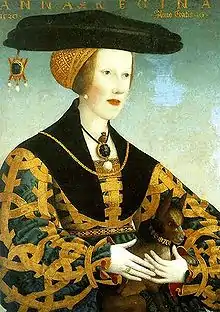Queen consort
A queen consort is the wife of a reigning king, or an empress consort in the case of an emperor. A queen consort usually shares her spouse's social rank and status. She holds the feminine equivalent of the king's monarchical titles, but historically, she does not share the regnant's political and military powers.
| Part of a series of articles on |
| Monarchy |
|---|
.svg.png.webp) |
| Politics portal |
In contrast, a queen regnant is a queen in her own right with all the powers of a monarch, who (usually) has become queen by inheriting the throne upon the death of the previous monarch. A well known example of a queen regnant is Queen Elizabeth I, daughter of Henry VIII and Anne Boleyn. She reigned as queen regnant from 1558 until her death in 1603.[1]
Titles
The title of prince consort for the husband of a reigning queen is rare. Examples are Henry Stuart, Lord Darnley, in Scotland; Antoine of Bourbon-Vendôme in Navarre; Francis, Duke of Cádiz, in Spain; and Ferdinand of Saxe-Coburg-Gotha in Portugal. Another example includes Albert of Saxe-Coburg and Gotha, whom in the event of marrying Queen Victoria of the United Kingdom of Great Britain and Ireland and her insistence that he be given a title of his status, became Albert, Prince Consort.[2]
Where some title other than that of king is held by the sovereign, his wife is referred to by the feminine equivalent, such as princess consort or empress consort.
In monarchies where polygamy has been practiced in the past (such as Morocco and Thailand), or is practiced today (such as the Zulu nation and the various Yoruba polities), the number of wives of the king varies. In Morocco, King Mohammed VI has broken with tradition and given his wife, Lalla Salma, the title of princess. Prior to the reign of King Mohammed VI, the Moroccan monarchy had no such title. In Thailand, the king and queen must both be of royal descent. The king's other consorts are accorded royal titles that confer status.
Other cultures maintain different traditions on queenly status. A Zulu chieftain designates one of his wives as "Great Wife", which would be the equivalent to queen consort. Conversely, in Yorubaland, all of a chief's consorts are essentially of equal rank. Although one of their number, usually the one who has been married to the chief for the longest time, may be given a chieftaincy of her own to highlight her relatively higher status when compared to the other wives; she does not share her husband's ritual power as a chieftain. When a woman is to be vested with an authority similar to that of the chief, she is usually a lady courtier in his service who is not married to him, but who is expected to lead his female subjects on his behalf.
Role
In general, the consorts of monarchs have no power per se, even when their position is constitutionally or statutorily recognized. Queen consorts often held an informal sort of power that was dependent on what opportunities were afforded to her. Should she produce a healthy heir, have an amiable personality, ambition and piety then chances were higher for her to gain this informal type of power.[3] They may have served roles as transfers of culture. Due to their unique position of being reared in one culture and then, when very young, promised into marriage in another land and culture, queen consorts may have served as a cultural bridge between nations. Based on journals, diaries and accounts, some queen consorts exchanged and introduced new forms of art, music, religion and fashion.[4] This is all based on the individual women, their experiences. If the Court, and even more so, the King were in favor of the Queen Consort she could gain power over time with cultural and social influence and with the birth of an heir. Often the queen consort of a deceased king (the dowager queen or queen mother) has served as regent if her child, the successor to the throne, was still a minor—for example:
- Anne of Kiev, wife of Henry I of France
- Munjeong, mother of King Myeongjong of Korea
- Mary of Guise, mother of Mary, Queen of Scots
- Catherine of Austria, grandmother of Sebastian of Portugal
- Marie de Medici, mother of Louis XIII of France
- Kösem Sultan, mother of Sultan Murad IV of the Ottoman Empire
- Luisa de Guzmán, mother of Afonso VI of Portugal
- Lakshmi Bai, the Rani of Jhansi and mother of Damodar Rao
- Maria Christina of Austria, mother of Alfonso XIII of Spain
- Emma of Waldeck and Pyrmont, mother of Wilhelmina of the Netherlands
- Anna Khanum, mother of Abbas II of Persia
- Helen of Greece, mother of King Michael of Romania
Besides these examples, there have been many cases of queens consort being shrewd or ambitious stateswomen and, usually (but not always) unofficially, being among the king's most trusted advisors. In some cases, the queen consort has been the chief power behind her husband's throne; e.g. Maria Luisa of Parma, wife of Charles IV of Spain.
Examples of queens and empresses consort


Past queens consort:
- Queen Jang, consort to Sukjong of Joseon. Demoted back in 1694 to the rank of hui-bin, Royal Noble Consort Joseon rank 1
- Queen Marie Antoinette, consort to Louis XVI of France[5]
- Queen Charlotte was George III's consort for 57 years, 70 days, between 1761 and 1818, making her Britain's longest-tenured queen consort.
- Queen Mary, consort of George V
- Queen Elizabeth, consort of George VI
- Queen Fabiola, consort of Baudouin I of the Belgians
- Queen Paola, consort of Albert II of Belgium
- Queen Anne Marie, consort of Constantine II of Greece
- Queen Geraldine, consort of Zog I of Albania
- Queen Marie José, consort of Umberto II of Italy
- Queen Kapiolani, consort of King Kalākaua of Hawaiʻi
- Queen Soraya Tarzi, consort of King Amanullah Khan of Afghanistan
- Tsaritsa Ioanna, consort of Tsar Boris III of Bulgaria
- Queen Regent Saovabha Phongsri, consort of Chulalongkorn of Siam
- Panapillai Amma (queen consort) Srimathi Lakshmi Pilla Kochamma Chempakaraman Arumana Ammaveedu, wife of Visakham Thirunal Maharajah of Travancore
- Queen Catherine, first queen consort of Henry VIII of England, was also regent when he was in a war in France.
- Queen Hortense, consort of Louis Bonaparte, King of Holland
- Shahbanu Farah Pahlavi, consort of Mohammad Reza Pahlavi, Shah of Iran
- Queen Wilhelmine, consort of William I of the Netherlands
- Queen Anna Pavlovna, consort of William II of the Netherlands
- Queen Sophie, first consort of William III of the Netherlands
- Queen Emma, second consort of William III of the Netherlands: When William died on 23 November 1890, Emma became regent (1890–1898) for her underaged daughter, Wilhelmina, the late king's only surviving child.
- Queen Ratna, second consort of Mahendra of Nepal
- Queen Sirikit, consort of King Bhumibol Adulyadej of Thailand
- Queen Ruth, consort of Seretse Khama, King of the Bamangwato Tswanas of Botswana
Past empresses consort:
- Empress Auguste Viktoria consort of Wilhelm II
- Empress Theodora, consort of Justinian I, East Roman Emperor[6]
- Empress Ruqaiya Sultan Begum, consort of Akbar the Great, the third Mughal Emperor.
- Empress Hürrem Sultan, consort of Suleiman the Magnificent, Sultan of the Ottoman Empire. Her imperial title was Haseki Sultan
- Empress Nurbanu Sultan, consort of Selim II, Sultan of the Ottoman Empire. Her imperial title was Haseki Sultan
- Empress Safiye Sultan, consort of Murad III, Sultan of the Ottoman Empire. Her imperial title was Haseki Sultan
- Empress Kösem Sultan, consort of Ahmed I, Sultan of the Ottoman Empire. Her imperial title was Haseki Sultan
- Empress Nur Jahan, consort of Jahangir, Mughal Emperor
- Empress Maria Theresa of Austria, consort of Francis I, Holy Roman Emperor
- Titular Empress Carlota Joaquina of Spain, consort of John VI of Portugal, Titular Emperor of Brazil
- Empress Maria Leopoldina, consort of Pedro I, Emperor of Brazil
- Empress Xiao Zhen Xian, consort of Xianfeng, Qing Emperor
- Empress Alexandra Feodorovna, consort of Nicholas II, Emperor and Autocrat of All Russia
- Empress Shubhadrangi, consort of Bindusara, Mauryan emperor
- Empress Durdhara, consort Chandragupta Maurya, first Mauryan emperor
- Empress Asandhimitra, principal consort (or Agramahishi) of Ashoka, third Mauryan emperor
- Empress Devi, first consort of Ashoka
- Empress Karuvaki, consort of Ashoka
- Empress Padmavati, consort of Ashoka
- Empress Tishyaraksha, consort of Ashoka
- Empress Michiko, consort of Emperor Akihito of Japan
Current queens consort:
- Queen Azizah, consort of Abdullah of Pahang and Malaysia
- Queen Nanasipauʻu Tukuʻaho, consort of Tupou VI of Tonga
- Queen 'Masenate, consort of Letsie III of Lesotho
- Queen Jetsun Pema, consort of Jigme Khesar Namgyal Wangchuck of Bhutan
- Queen Saleha, consort of Hassanal Bolkiah of Brunei Darussalam
- Queen Máxima, consort of Willem-Alexander of the Netherlands
- Queen Mathilde, consort of Philippe of Belgium
- Queen Rania, consort of Abdullah II of Jordan
- Queen Silvia, consort of Carl XVI Gustaf of Sweden
- Queen Suthida, consort of Vajiralongkorn of Thailand
- Queen Letizia, consort of Felipe VI of Spain
- Queen Sonja, consort of Harald V of Norway
- Queen Mantfombi, principal consort (or Inkosikazi Enkhulu) of Goodwill Zwelithini of Zululand, South Africa. She is also simultaneously a princess of eSwatini.
Current empress consort:
- Empress Masako, consort of Emperor Naruhito of Japan
Current queens consort in federal monarchies
- Queen Zarith Sofiah, consort of Ibrahim Ismail of Johor
- Queen Norashikin, consort of Sharafuddin of Selangor
- Queen Zara Salim, consort of Nazrin Shah of Perak
Because queens consort lack an ordinal with which to distinguish between them, many historical texts and encyclopedias refer to deceased consorts by their premarital (or maiden) name or title, not by their marital royal title (examples: Queen Mary, consort of George V, is usually called Mary of Teck, and Queen Maria José, consort of Umberto II of Italy, is usually called Marie José of Belgium).
See also
- Consort crown
- Prince consort
- Princess consort
- Haseki Sultan
- Sultana
- Royal Noble Consort (Korea)
- List of Bohemian consorts
- List of Burmese consorts
- List of British consorts
- List of Bulgarian consorts
- List of royal consorts of Canada
- List of Danish consorts
- List of Dutch consorts
- List of Queens and Empresses of France
- List of Georgian consorts
- List of Hawaiian royal consorts
- List of Hungarian consorts
- List of Norwegian consorts
- List of Pre-colonial Filipino Consorts
- List of Portuguese queens
- List of Spanish consorts
- List of Swedish consorts
- List of Tongan consorts
References
- Warnike, Retha (2007). "Elizabeth I: Gender, Religion and Politics". History Review. 58 (30): 30–31.
- Chancellor, Frank B. (1931). Prince Consort. New York: The Dial Press. pp. 215–218.
- Orr, Clarissa Campbell (2004). Queenship in Europe 1660-1815: The Role of the Consort. Cambridge: Cambridge University Press. pp. 1–9. ISBN 0521814227.
- Watanabe- O'Kelly, Helen (2016). "Cultural Transfer & The Eighteenth Cenutry Queen Consort". German History. 34 (2): 279–292. doi:10.1093/gerhis/ghw002.
- "Marie-Antoinette | Facts, Biography, & French Revolution". Encyclopedia Britannica. Retrieved 22 March 2020.
- Phillips, Lawrence Barnett (1871). The Dictionary of Biographical Reference: Containing One Hundred Thousand Names, Together with a Classed Index of the Biographical Literature of Europe and America. S. Low, Son, & Marston. p. 900.
.svg.png.webp)
